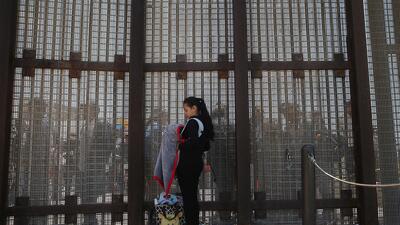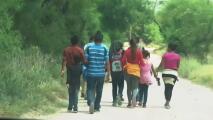Would a 2,000-mile-long border wall even work?

Republican presidential candidate Donald Trump is sticking to the promise he made on the first day of his campaign: He will build a wall. “On day one, we will begin working on an impenetrable, physical, tall, powerful, beautiful southern border wall,” he said last week. That would be a 1,989-mile-long wall, from coast to coast.
But building that wall would be very complicated. The U.S. government has already been reinforcing security along its southern border for the past 20 years. It now has about 21,000 border patrol agents, radars, watch towers, spotlights, helicopters, drones – and yes, even a wall.
In fact, there are already about 700 miles of metal fencing or metal plates and other physical barriers between the United States and Mexico.
Congress approved the construction of a border fence in 2006. Majorities of both parties, including then-Senator Hillary Clinton, voted for the law, which called for a barrier along some 700 miles of the U.S.-Mexico border. By 2011, Border Patrol chief Michael Fisher reported to Congress that 650 miles had been built.
But the Department of Homeland Security reported in 2011 that the border was still “vulnerable to illegal activity, including the smuggling of people and illegal drugs,” according to a U.S. Government Accountability Office (GAO).
And while Trump has forcefully made and repeated his promise of a longer wall, the existing barrier has created many headaches for the U.S. government. The so-called Secure Border Initiative cost $4.5 trillion from 2005 to 2010 alone, according to official figures.
Here are some of the challenges Trump could face in building an expanded wall.
1. The Rio Grande
Most of the U.S.-Mexico border is defined by water, not land. The Rio Grande marks the border between Texas and northern Mexico for 1,254 miles. And only about 100 miles are covered by the existing wall.
In fact, treaties between the United States and Mexico forbid the construction of a fence or wall on both the river and along the riverbed.
That would make it pretty hard for Trump to build his wall in many stretches of the border, says Tony Payán, who heads the Mexico Institute at the Wilson Center and teaches on both sides of the border.
“Is it possible to build a border wall? Yes,” Payán says. “Is it possible to build it along the 1,200-mile banks of the Rio Grande? No.”
In places like El Paso, Texas, there is a strip of land between the U.S. side of the river and the fence. But in other places the fence was built several miles from the water.
“What's the use of building a wall ten miles north of the river?” asked Payán.
2. Private properties
In Nogales, Arizona, the backyards and even the kitchens of Mexican homes can be seen across the border wall. Hundreds of American families live close to the current fence.
“Parts of the border, particularly in Texas … are part of private lands … ranches, where the ranchers do not necessarily want to have fencing or a wall close to them," said Doris Meissner, who headed the U.S. Citizenship and Immigration Services from 1993 to 2000 and is now a senior fellow at the Migration Policy Institute in Washington D.C. "If the federal government would decide to build there, it would [have to] exercise eminent domain.”
Obtaining the land to build just a few miles of wall in the past turned into a major headache for U.S. officials: the government had to file lawsuits against hundreds of landowners. In one case, the government had to pay a woman $56,000 for three acres in San Benito, Texas, that had been in her family for generations.
3. Rough topography and endangered wildlife
“The varied topography of the borderlands—ranging from steep mountains to deep canyons and rivers—make building a barrier in some areas extremely difficult,” professors Joseph Nevins and Timothy Dunn wrote in a 2008 report published by the North American Congress on Latin America (NACLA).
The wall also has caused flooding in southern Arizona after strong rains because it blocks the flow of the water.
The border fence also affects desert wildlife, including jaguars, along parts of the border like the Buenos Aires National Wildlife Refuge in southern Arizona. That has sparked protests since 2005.
4. Local opposition
Some locals protested when parts of the wall were built in the 2000s, according to Anna Ochoa O'Leary, a researcher at the University of Arizona.
“The people of Arizona opposed it and there were protests, petitions to the government, lots of meeting with the Border Patrol where residents told the officials about their problems and concerns,” said Ochoa O'Leary.
Most border residents remain opposed to the wall. About 86 percent of those who live on the Mexican side and 72 percent of those on the U.S. side do not want a border wall, according to an April survey by Cronkite News at Arizona State University, Univision Noticias and the Dallas Morning News.
5. A more deadly crossing
More than 6,000 people have died crossing the U.S.-Mexico border since 1998, according to a 2014 International Organization for Migration report.
Several studies link the militarization of the border to the large number of border deaths, says a March report by four university professors in the Journal of Latin American Geography. The report linked the rising number of deaths during border crossings to increased border security since 2006, including the construction of the walls and fences, the deployment of more border agents and the use of new equipment.
Other experts agree there is a correlation between increased border security and border deaths.
"It’s not just the fencing," said Meissner. "It’s the whole border effort which has pushed the trafficking of migrants to more and more remote areas, which tend to be deserts and dangerous areas, so deaths have increased."
6. High costs
The GAO reported in 2009 that the costs of building the wall were far higher than expected, and that land acquisitions had added a significant cost to the project.
The cost of the wall varied by section. From 2006 and 2010, the government spent between $3.9 million and $16 million of taxpayer money for each mile of fence built. In comparison, one mile of a two-lane road can cost some $2 million to $5 million.
There are also required maintenance costs due to the natural wear and tear or damage caused by migrants and drug traffickers. A 2006 Congressional Research Service study put the overall cost of one mile of fence at somewhere between $16 million and $70 million every 25 years.
Each mile of the wall Trump promises to build would cost even more because he has promised improvements. "We will use the best technology, including above- and below-ground sensors," Trump said last week.
7. Native American land
The Native American Tohono O’Odham tribe lives on both sides of the border near Nogales, Arizona. “They did not cross the border,” Payán said. “The border crossed them.”
A wall would divide their land. Tribe members have moved between the north and south sides for centuries to take their children to school, go to the doctor or visit relatives.
But it's increasingly difficult. Today, they can cross if they have cards identifying them as members of the tribe, according to the website Open Borders. The page also notes that about 30 other Native American tribes have been affected by increased U.S. border security.
8. Migration
The National Research Council, which brings together experts on many fields, published a 2011 study arguing that a wall does not dissuade migrants from trying to cross the border, and only makes it more difficult and expensive. What's more, violence in migrants' home countries, especially in Central America, is likely worse than situations on the border.
The study also argued that the wall also keeps people from returning to their home countries.
In recent years, the number of detentions of undocumented migrants along the border has dropped far below the peak years from 1995 to 2006. Border apprehensions have fallen 80% since a peak in 2000, according to David Aguilar, former Chief of the United States Border Patrol during the George W Bush administration.
In the 2015-2016 fiscal year apprehensions at the border are expected to number around 380,000 people, down from 1.6 million in 2000. A 2,000 mile border wall is "ludicrous," Aguilar told Public Radio International on Thursday.
"That is not necessary and it would be a tremendous waste of treasure ... it would not help the situation as it relates to control and management of our borders," added Aguilar who is a principal at Global Security and Innovative Strategies (GSIS) a security consulting and business advisory firm headquartered in Washington, DC.
There are many reasons for the drop, and not just the wall, experts say.
“It's very probable that the wall has a lot to do with this, but the arguments for building more wall cannot be based solely on detention statistics,” security consultant Sylvia Longmire wrote in her book Border Insecurity.
Most experts say a variety of factors has affected the number of detentions. The Great Recession reduced the attraction of the U.S. economy and more agents and technology are now on the lookout for illegal crossings.
Aguilar also points out that resources would be better spent on tackling the 500,000 people last year who flew into the country at national airports and overstayed their visas.
9. Drug traffickers
“As long as there are people in the United States ready to pay, drug traffickers will find a way to cross, although that will increase the price,” said Ochoa O'Leary. “It might put more power and more money in the hands of drug traffickers to design better strategies for smuggling drugs into the United States.”
Tunnels along the border are common: at least 100 drug-smuggling tunnels were found under Nogales from 1990 to 2014, according to Border Patrol statistics. On Aug. 29, Border Patrol agents announced the discovery of a tunnel in Nogales that covered 103 feet on the Mexican side and 46 feet into U.S. territory. Smugglers have also used catapults to fling drugs into the United States as well as ultralights.
10. Intrepid climbers
It's happened more than once: young men quickly scale the border wall, in urban areas and broad daylight, carrying what is believed to be drugs on their backs. They are known as narco-spiders, and this video from Nogales shows the barrier is not that difficult to breach.
But migrants can die when they try to climb the wall. In Nogales, authorities found the body of a 32-year-old Mexican woman on June 16. Nogales police spokesman Sgt. Roberto Fierros said the woman apparently fell and hit her head.



